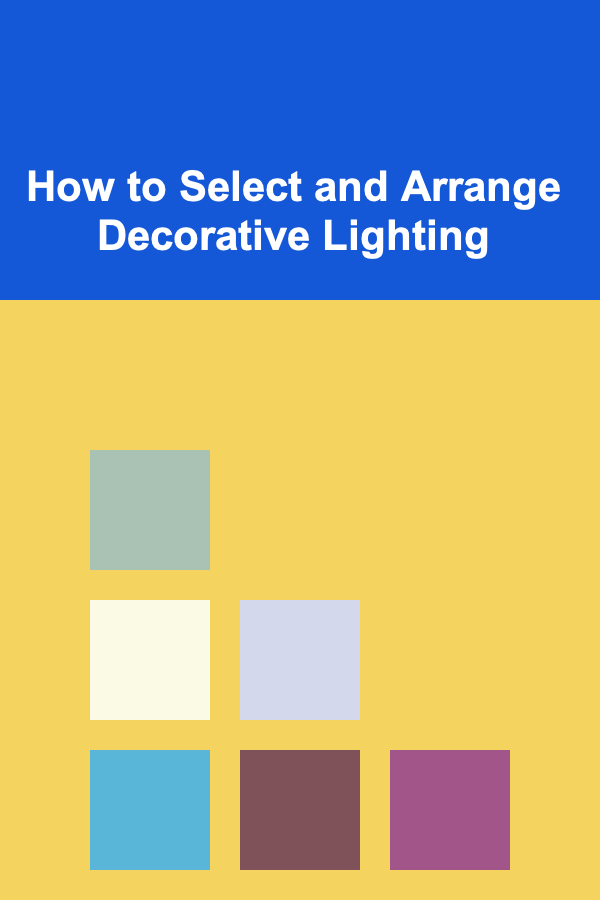
How to Select and Arrange Decorative Lighting
ebook include PDF & Audio bundle (Micro Guide)
$12.99$8.99
Limited Time Offer! Order within the next:

Decorative lighting plays a pivotal role in the design and atmosphere of a space. It adds aesthetic value while also serving practical purposes like enhancing visibility and creating ambiance. However, choosing the right decorative lighting and arranging it properly can be a complex task. With countless lighting options, styles, and techniques available, it can be overwhelming to know where to start. This article will explore the key principles and considerations for selecting and arranging decorative lighting in your home or business, ensuring that every corner of your space benefits from the perfect illumination.
Understanding the Basics of Lighting
Before diving into specific types of decorative lighting, it's important to understand the fundamental concepts of lighting in interior design. Decorative lighting is one aspect of a broader lighting strategy that also includes:
- Ambient Lighting: The primary source of light, typically provided by ceiling lights or overhead fixtures. It is meant to provide uniform illumination across the entire space.
- Task Lighting: This type of lighting is designed for specific tasks, such as reading, cooking, or working. Examples include desk lamps, under-cabinet lights, and pendant lights.
- Accent Lighting: Accent lighting is used to highlight certain features of a room, such as artwork, architectural details, or plants. Spotlights, track lights, and wall sconces are common forms of accent lighting.
Decorative lighting specifically falls into the category of accent lighting, though it often serves dual purposes of enhancing aesthetics and providing softer, atmospheric illumination. To design an effective lighting scheme, a combination of these three types is typically needed.
Identifying Your Lighting Needs
The first step in selecting decorative lighting is understanding the unique needs of the space. Consider the following factors when determining how much decorative lighting is required:
A. Purpose of the Space
The function of the room plays a crucial role in the lighting decisions. For example, a living room will need softer, more ambient lighting to create a relaxing atmosphere, while a kitchen or study will require more task-oriented lighting for cooking, working, or reading.
- Living Room: A mixture of ambient and decorative lighting can be used to create a cozy, inviting environment. Consider wall sconces, pendant lights, or chandeliers that can double as decorative elements.
- Dining Room: A statement chandelier or pendant light can serve as the focal point above the dining table, adding both decorative and task lighting.
- Bedroom: The lighting in a bedroom should evoke a tranquil and restful atmosphere. Consider adding decorative lighting such as table lamps, floor lamps, or wall-mounted lights that create a gentle glow without being too harsh.
- Bathroom: While function is key in a bathroom, accent lighting can still be used effectively to enhance the design. Consider small pendant lights or sconces that frame mirrors or artwork.
B. Room Size and Layout
The size and layout of the room will dictate the number and placement of decorative lighting fixtures. Larger rooms may benefit from multiple light sources, while smaller rooms can be complemented with fewer, more focused lighting elements. You'll want to ensure that the lighting works with the room's design and doesn't overwhelm or under-illuminate the space.
- Open-Concept Spaces: In open-plan living areas, it's essential to use lighting that can adapt to different zones. Use decorative lighting to delineate different areas while keeping the overall ambiance cohesive.
- Nooks and Corners: Consider using decorative lighting in smaller, intimate spaces to create warmth and visual interest. Wall-mounted sconces or smaller pendant lights work well in these situations.
C. Desired Mood and Atmosphere
Lighting has a direct influence on the mood and atmosphere of a room. Depending on the ambiance you want to create, decorative lighting can be used to set the tone. Soft, dim lighting can evoke a calm, romantic feel, while bright, colorful lighting can inject energy and vibrancy into the room.
- Warm Lighting: Ideal for creating a relaxed and cozy atmosphere. Choose light bulbs with a color temperature of around 2700K.
- Cool Lighting: Works well in modern, minimalist spaces, and helps with focus and energy. Choose bulbs in the 4000-5000K range.
- Colorful Lighting: LED lights with adjustable color temperatures or even color-changing bulbs can be used creatively to add drama and excitement.
Types of Decorative Lighting
Once you have a sense of the lighting needs and preferences for your space, the next step is to explore the different types of decorative lighting available. Below are some of the most popular options to consider:
A. Chandeliers
Chandeliers are a classic choice for adding both decorative appeal and illumination. These overhead fixtures are often used in entryways, dining rooms, or living areas as a focal point. When choosing a chandelier, consider the style, size, and scale in relation to the room.
- Traditional Chandeliers: Made with crystal or glass elements, often intricate in design, these work well in more formal spaces.
- Modern Chandeliers: Sleeker and more minimalistic, these are perfect for contemporary spaces.
- Rustic Chandeliers: Made from wood or wrought iron, these are ideal for farmhouse or industrial-style interiors.
B. Pendant Lights
Pendant lights are versatile and can be used for both decorative and task lighting. They come in various designs, including single pendants, multi-light clusters, and linear arrangements. Pendant lights are often used above kitchen islands, dining tables, or as accent lighting in living rooms.
- Single Pendant: Great for concentrated lighting over specific areas like a table or countertop.
- Cluster Pendant: A grouping of pendants creates visual interest and is ideal for larger spaces or dining areas.
- Adjustable Pendants: These allow for flexibility, enabling you to adjust the height and intensity of the light as needed.
C. Wall Sconces
Wall sconces are an excellent way to introduce decorative lighting to smaller spaces or to add visual interest to a room. These fixtures can be used to highlight specific areas, such as mirrors, artwork, or architectural details. Wall sconces come in various shapes, styles, and finishes, allowing you to select one that aligns with your interior design.
- Uplight Sconces: These direct light upward, creating a soft glow on the walls and ceiling.
- Downlight Sconces: These cast light downward, providing focused task lighting for reading or accentuating furniture.
- Swing Arm Sconces: Adjustable sconces can be moved to different positions, offering flexibility in how you light the space.
D. Floor and Table Lamps
Lamps provide both functional lighting and decorative appeal, especially in spaces that require additional lighting without the need for overhead fixtures. A well-chosen floor or table lamp can add character and style to any room.
- Table Lamps: Perfect for desks, nightstands, or console tables, table lamps come in an array of designs to suit every style, from vintage to modern.
- Floor Lamps: Ideal for larger rooms, floor lamps can provide general or task lighting and often serve as statement pieces in the room. Consider styles such as arc lamps, tripod lamps, or torchiere lamps.
E. LED Strips and Fairy Lights
For a more whimsical and creative approach, LED strip lights and fairy lights can be used as decorative accents. These lights are particularly effective in spaces where you want to add a subtle yet impactful lighting effect, such as around mirrors, shelves, or along the baseboards.
- Fairy Lights: Small, delicate lights that can be draped over furniture, artwork, or architectural features for a magical, ethereal glow.
- LED Strips: These flexible lights can be placed in various configurations and are often used under cabinets, along ceilings, or behind furniture to create ambient or accent lighting.
F. Smart Lighting
Smart lighting is the cutting edge of decorative lighting, offering customizable and programmable options. With smart bulbs and connected lighting systems, you can change the color, brightness, and timing of the lights to fit your needs and moods.
- Smart Bulbs: These can be controlled via apps or voice assistants, allowing you to adjust the lighting without moving.
- Smart Fixtures: Some pendant lights, chandeliers, and floor lamps are equipped with smart technology, enabling features like remote control and color changes.
How to Arrange Decorative Lighting
Now that you've selected the right types of decorative lighting for your space, the next step is to think about placement. Proper arrangement of lighting is essential to ensure that it fulfills its functional and aesthetic roles.
A. Create Focal Points
When arranging your decorative lighting, it's crucial to create focal points that draw attention to key elements in the room. Use pendant lights, chandeliers, or spotlights to highlight artwork, furniture pieces, or architectural features such as fireplaces or bookshelves.
- Living Room: Use a statement chandelier or a cluster of pendant lights as a focal point, while wall sconces or table lamps can provide softer, surrounding light.
- Dining Room: Position a large pendant or chandelier directly above the dining table to create a visual anchor.
B. Layer Your Lighting
Effective decorative lighting involves layering different light sources. Combining overhead lighting with task lighting and accent lighting helps to create depth and dimension in a room.
- Ambient Lighting: Start with overhead fixtures like chandeliers or recessed lights.
- Task Lighting: Add table lamps or floor lamps to provide more focused light for specific tasks.
- Accent Lighting: Integrate smaller fixtures like wall sconces, LED strips, or track lighting to enhance the atmosphere and highlight key design elements.
C. Consider the Height and Scale of Fixtures
When placing lighting fixtures, make sure to consider the height of the ceiling and the scale of the room. In larger spaces, you may need larger or more dramatic fixtures to fill the space, while smaller rooms benefit from compact or hanging lights that don't overwhelm the area.
- High Ceilings: Use tall floor lamps or large chandeliers to fill the vertical space and create balance.
- Low Ceilings: Opt for flush-mount or semi-flush ceiling lights that don't take up too much space.
D. Mind the Shadows and Glare
In some situations, lighting can create harsh shadows or glare that disrupts the ambiance. To avoid this, place lights in such a way that they minimize direct glare and distribute light evenly across the room. Dimmer switches and adjustable fixtures can help you control the intensity of the light to reduce harsh effects.
- Shadows: Place wall sconces at the right height and angle to avoid casting unflattering shadows.
- Glare: Use frosted glass or diffusers on bulbs to soften the light and minimize glare.
Conclusion
Decorative lighting has the power to completely transform a space, providing both functional illumination and aesthetic value. By carefully selecting the right types of lighting, considering your room's needs, and arranging fixtures thoughtfully, you can create an atmosphere that enhances the overall design and mood of the space. Whether you're outfitting a cozy living room, a stylish dining room, or a modern office, the right decorative lighting can be the finishing touch that brings your design vision to life. With a little planning and creativity, your lighting can elevate your space to new levels of beauty and functionality.

How to Conduct Efficient Virtual Meetings
Read More
How to Start Investing in Bonds for Low-Risk Income
Read More
How to Upgrade Your Rental Property Without Major Renovations
Read More
How to Understand the Trade-Offs of Different FIRE Paths
Read More
How To Train Your Brain for Better Decision-Making
Read More
How To Explore Gene Therapy for Inherited Disorders
Read MoreOther Products

How to Conduct Efficient Virtual Meetings
Read More
How to Start Investing in Bonds for Low-Risk Income
Read More
How to Upgrade Your Rental Property Without Major Renovations
Read More
How to Understand the Trade-Offs of Different FIRE Paths
Read More
How To Train Your Brain for Better Decision-Making
Read More